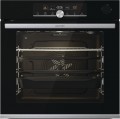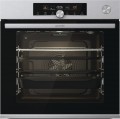Cooking temperature
The cooking temperature range allows you to understand which special tasks are subject to the oven. The lower temperature from which the oven starts heating, usually, is in the range of +30 to +50 ˚C. So, for example, the minimum heating temperature at
+30 ˚C allows you to defrost products. Models with a minimum of
40 ˚C and
50 ˚C allow you to heat ready meals, heat tableware (before serving), dry crackers, etc.
Cooking modes
Among the cooking modes, one can single out modes that are relevant for models in the role of ovens (these are
grill,
convection,
convection with heater,
double convection,
rotisserie fork,
temperature probe), as well as special operating modes that turn the oven into another device on the kitchen table (
microwave oven,
built-in steamer and
steam cooking)
— Microwave. The presence of a microwave heater in the oven, along with an electric or gas one (see "Oven"). This feature significantly expands the functionality of the device: a microwave generator is convenient for heating and defrosting food, and its use in combination with the main heater allows you to speed up the cooking time and provide better heating, especially when cooking the product as a whole piece (for example, when baking boiled pork). At the same time, such combined ovens are more expensive than
conventional ones not equipped with a microwave.
— Built-in steamer. Possibility of using the oven for steam cooking. Cooking is carried out in the main chamber of the oven, and the steam comes from a special reservoir into which water is poured in advance. This method is con
...sidered more healthy than traditional cooking or frying. In addition, it often turns out to be optimal for people with dietary restrictions. However, models with steamer functions are also more expensive than usual ones.
— Steam cooking. Water is poured into a special tray at the bottom of the oven, and evaporates under the influence of high temperature, thereby steaming the dishes in the device. However, such ovens have basic capabilities and do not have a separate programme, modes, or sensors that would monitor the work and the steam cooking process itself.
— Grill. Device for cooking food using thermal radiation. The grill allows you to get dishes with a fried surface or crispy crust. However, this method of cooking is considered healthier than frying in oil. This function is especially useful in combination with a rotisserie fork (see below).
— Convection. This function implies the presence of a fan in the oven, which forcibly draws heated air through the working chamber. It ensures a more even distribution of heat than with natural (without a fan) air circulation, which has a positive effect on the heating efficiency and the quality of cooking.
– Convection with heater. The combination of convection for uniform distribution of heated air flows and an annular heater, which is located around the fan. In this cooking mode, an increase in the temperature of the air driven by the blades is ensured. This type of dry convection is more efficient as it allows the circulating air to warm up evenly faster.
— Double convection. Improved convection function (see above), in which two fans are responsible for air circulation at once. According to the manufacturers, this ensures the evenest distribution of hot air throughout the volume of the oven and, accordingly, high-quality cooking. In addition, double convection is found in models with an additional chamber — where each fan is responsible for its own oven compartment.
— Rotisserie fork. A device in the form of a fork on which pieces of meat, chicken or other food can be strung. When cooking, this fork rotates, which allows you to evenly heat the dish from all sides. In modern ovens, this function is necessarily combined with a grill (see above); other cooking methods for a rotisserie fork are of little use or do not make sense.
— Temperature probe. A device for measuring the temperature of cooked food. It looks like a thin rod with a temperature sensor at the end. With such a rod, you can measure the temperature both outside and inside the dish being prepared, determining its condition and degree of readiness. Temperature probes are especially useful when roasting meat.
— Double oven. The ability to cook two different dishes at the same time in the oven saves time — for example, you can bake meat in the upper chamber and cook cake layers in the lower one. And the role of a partition between the chambers is played by a baking sheet, which can be removed and the oven used for a total volume.
— Custom programme. Ability to create your own oven programme. Such programmes are similar to automatic ones (for more details, see “Number of automatic programmes”). However, unlike the latter, you can change them at your own discretion and save them in the oven’s memory, which gives you ample features to customize the oven to your preferences.
— Defrosting. A programme for gentle defrosting of frozen foods. In this mode, the oven operates at a low intensity — so that the contents effectively thawed but, at the same time, did not bake. Data on the defrosting time required for a certain amount of a certain product is usually given in the instructions for use.Number of modes
The number of cooking modes provided in the design of the oven. In this case, the cooking mode means the general opertaion mode — for example, “heating”, “heating + convection”, etc. Accordingly, this indicator strongly depends on additional equipment (see "Features"). However, even in similar models, the number of modes may be different. In general, the
more cooking modes, the more cooking options, the easier it will be to choose the optimal mode for a specific situation.
Features
Among the ovens features, one can single out the basic ones inherent in most devices (
gas control,
auto ignition,
thermostat, timer,
auto switch-off,
child lock), and top-level features that are relevant for devices of the highest category (
control via Internet,
built-in video camera,
TFT display). More about them:
— Gas control. Thermoelectric system designed to protect against gas leakage. If the flame is accidentally extinguished, the gas supply to the chamber is immediately stopped. The gas control usually includes a thermocouple (to determine the presence or absence of a flame) and a gas blocking device.
— Auto ignition. A system that provides automatic ignition of gas simultaneously with the start of its supply. The user does not need to use matches or a lighter, press a separate button, etc.: the gas ignites immediately when the handle is turned. Found only in models with appropriate heaters (see "Oven").
— Thermostat. A device that maintains a predetermined temperature in the oven.
— Timer. A device that provides a countdown time and allows you to control the cooking process precisely. After the set time has elapsed, the timer, usually, beeps, and in some models, i
...t also turns off the heating. Timers can be either mechanical or electronic; the first one is simple and inexpensive, and the second one is more accurate and better combined with additional features (for example, auto switch-off).
— Auto switch-off. In this case, we are talking about a function that provides automatic shutdown of the oven according to the timer (see below); the timer itself does not imply auto-off, so if such an ability is important, you should choose a model where it is directly stated. Also, auto switch-off can be provided as a protective system that prevents overheating — such automation turns off the oven if no commands have been received from the user for a long time or when the temperature rises critically.
— Control via Internet. The specific control method may be different: some models use an application that needs to be installed on a smartphone or tablet, while others use a regular web page that can be opened in any browser. These details should be specified separately. Anyway, this function allows you to access control from anywhere in the world where there is access to the World Wide Web. For example, in the morning you can load food for a dish into the oven, and when you leave work, launch a cooking programme via the Internet, and get a ready-made hot dish by the time you return home. Also, note that such control usually allows not only to give commands but also to receive notifications from the oven. In particular, the device can report the progress of the programme, readiness, various problems, etc.
— Video camera. The presence of a built-in camera for more detailed control of the preparation of the dish. The user can visually control the cooking process without opening the oven door. Most often, the built-in camera transmits video via a wireless Wi-Fi connection. As a pairing device, you can use both a computer with a laptop and a tablet/smartphone. Of course, on a mobile/computer device, you will need to install proprietary software. The video camera is especially relevant in cases where the oven is used to prepare complicated meals. Regular control, without disturbing the temperature regime due to the opening of the door, minimizes the risk of food spoilage.
— TFT display. The oven has its TFT display. In this case, we mean a screen that does not consist of segments but pixels and is suitable for displaying various types of data: numbers, text, graphic symbols, pictures, etc. A wide variety of information can be displayed on the TFT display, which makes the operation of the oven more convenient. However, this variety is only relevant for advanced models with an abundance of functions, so the presence of such a screen is usually a sign of a premium oven.
— Child lock. In modern ovens, it can be done in different ways. So, in some models, you can block the oven door — so that a curious little child cannot open it during cooking and get burned. In other devices, a control panel lock is also provided — thanks to it, the baby will not be able to turn on/off the device or change the cooking mode. Child lock is unlocked in a non-obvious way accessible to an adult but not to a child — for example, by simultaneously pressing two buttons.Number of door glasses
The number of layers of glass in the viewing window of the oven door.
Modern models, usually, have from 2 to 4 glasses. The
more glasses, the less heat loss and the more economical the oven, but this parameter also affects the cost.
Oven cleaning
The type of inner cleaning provided in the oven. Note that pollution has to be removed with a rag or sponge, but modern ovens often provide various tricks that facilitate the process. The options might be:
—
Catalytic. A special wall coating is used in ovens with this cleaning method: it breaks down fats and other stubborn dirt into constituent elements that can be easily removed. The effectiveness of such a coating decreases over time, but it is enough for at least several years of full use. It should be noted that the catalytic coating can be implemented by applying it to special removable plates that are installed on the back or side walls of the oven chamber.
—
Steam cleaning. Cleaning with hot steam, which softens dried-on dirt and partially breaks down fats. In some models, there is a built-in steam generator for this, in others it is enough to put a container of water in the working chamber and turn on the cleaning program.
—
Pyrolytic. Cleaning by heating the chamber to a very high temperature — about 500 ° C. At this temperature, most of the contaminants are incinerated into ash, which can then be easily removed. Pyrolytic cleaning is considered the most effective, but ovens with this function are expensive, time consuming, require significant electricity/gas consumption, and can lead to unpleasant odors.

